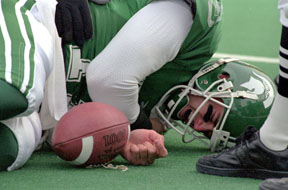 Derrick Williams was living out his dream, playing college football as a receiver. He had just caught a 35-yard pass and was running between the defenders, heading for the goal line. As he turned sharply to avoid being tackled, he felt a pop in his knee and fell sharply to the ground in pain.
Derrick Williams was living out his dream, playing college football as a receiver. He had just caught a 35-yard pass and was running between the defenders, heading for the goal line. As he turned sharply to avoid being tackled, he felt a pop in his knee and fell sharply to the ground in pain.
The team athletic trainer ran to the field to assess the situation. The trainer started with a routine field exam to rule out injuries that would prevent the athlete from being moved, such as back, head injuries or fractures. After deciding the injury was isolated to the knee, Derrick was able to stand with help and be assisted from the field.
Although the above web site discusses a medical doctor's responsibilities in evaluating an injured athlete, an athletic trainer would follow the same guidelines.
- 1. What are the steps to evaluating an unconscious athlete?
- 2. What are the steps to evaluating a conscious athlete?
- 3. What are the responsibilities of a first responder at the scene of an athletic injury?
Using the link below and the Case Study Workbook:
Review Basic Anatomy of the Knee
The trainer continued to work on assessing the injury. After ruling out other knee injuries, the trainer performed testing to confirm his suspicions of a tear in the anterior cruciate ligament
- 4. Identify the location of the following: ACL, PCL, lateral and collateral ligaments, lateral and medial meniscus. Describe two functions of the ACL.
